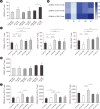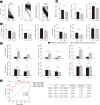CD69 Expression is Negatively Associated With T-Cell Immunity and Predicts Antiviral Therapy Response in Chronic Hepatitis B
- PMID: 39703148
- PMCID: PMC11788699
- DOI: 10.3343/alm.2024.0178
CD69 Expression is Negatively Associated With T-Cell Immunity and Predicts Antiviral Therapy Response in Chronic Hepatitis B
Abstract
Background: The function of CD69 expressed on T cells in chronic hepatitis B (CHB) remains unclear. We aimed to elucidate the roles of CD69 on T cells in the disease process and in antiviral therapy for CHB.
Methods: We enrolled 335 treatment-naive patients with CHB and 93 patients with CHB on antiviral therapy. CD69, antiviral cytokine production by T cells, T-helper (Th) cells, and inhibitory molecules of T cells were measured using flow cytometry, and clinical-virological characteristics were examined dynamically during antiviral therapy.
Results: CD69 expression on CD3+, CD4+, and CD8+ T cells was the lowest in the immune-active phase and was negatively correlated with liver transaminase activity, fibrosis features, inflammatory cytokine production by T cells, and Th-cell frequencies but positively with inhibitory molecules on T cells. CD69 expression on CD3+, CD4+, and CD8+ T cells decreased after 48 weeks of antiviral therapy, and patients with hepatitis B e antigen (HBeAg) seroconversion in week 48 showed lower CD69 expression on T cells at baseline and week 48. The area under the ROC curve of CD69 expression on T cells at baseline for predicting HBeAg seroconversion in week 48 was 0.870, the sensitivity was 0.909, and the specificity was 0.714 (P =0.002).
Conclusions: CD69 negatively regulates T-cell immunity during CHB, and its expression decreases with antiviral therapy. CD69 expression predicts HBeAg seroconversion in week 48. CD69 may play an important negative role in regulating T cells and affect the efficacy of antiviral therapy.
Keywords: Antiviral agents; CD69; Chronic hepatitis B; T cell; Therapy.
Conflict of interest statement
None declared.
Figures








Similar articles
-
Treatment with telbivudine positively regulates antiviral immune profiles in Chinese patients with chronic hepatitis B.Antimicrob Agents Chemother. 2013 Mar;57(3):1304-11. doi: 10.1128/AAC.02181-12. Epub 2012 Dec 28. Antimicrob Agents Chemother. 2013. PMID: 23274669 Free PMC article.
-
Viral infection parameters not nucleoside analogue itself correlates with host immunity in nucleoside analogue therapy for chronic hepatitis B.World J Gastroenterol. 2014 Jul 28;20(28):9486-96. doi: 10.3748/wjg.v20.i28.9486. World J Gastroenterol. 2014. PMID: 25071343 Free PMC article. Clinical Trial.
-
Programmed death 1 expression during antiviral treatment of chronic hepatitis B: Impact of hepatitis B e-antigen seroconversion.Hepatology. 2008 Sep;48(3):759-69. doi: 10.1002/hep.22419. Hepatology. 2008. PMID: 18697210
-
Antiviral therapy response in patients with chronic hepatitis B and fatty liver: A systematic review and meta-analysis.J Viral Hepat. 2024 Jul;31(7):372-382. doi: 10.1111/jvh.13942. Epub 2024 Apr 8. J Viral Hepat. 2024. PMID: 38590002
-
Differentiation of Cytotoxic CD8+ T Cell Subsets Under Tumor Progression: Can CD69 Be a New Therapeutic Target?Cancer Sci. 2025 Jun;116(6):1500-1507. doi: 10.1111/cas.70055. Epub 2025 Mar 25. Cancer Sci. 2025. PMID: 40133063 Free PMC article. Review.
Cited by
-
Investigation of the relationship between chronic hepatitis B and tuberculosis using bioinformatics and systems biology approaches.Front Med (Lausanne). 2025 Jun 12;12:1519216. doi: 10.3389/fmed.2025.1519216. eCollection 2025. Front Med (Lausanne). 2025. PMID: 40575568 Free PMC article.
-
Extracellular Vesicles as Biomarkers in Chronic Hepatobiliary Diseases: An Overview of Their Interplay.Int J Mol Sci. 2025 Jun 30;26(13):6333. doi: 10.3390/ijms26136333. Int J Mol Sci. 2025. PMID: 40650114 Free PMC article. Review.
-
Downexpression of miR- 17 - 5p and miR- 125a- 5p is Potentially Associated with the Renal Impairment Through STAT- 3 and CD69 in Multiple Myeloma Adult Patients.Biochem Genet. 2025 Apr 23. doi: 10.1007/s10528-025-11094-3. Online ahead of print. Biochem Genet. 2025. PMID: 40266492
References
MeSH terms
Substances
LinkOut - more resources
Full Text Sources
Research Materials

